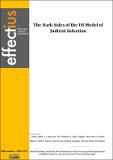| dc.description.abstract |
Each society should be based on justice. Justice in turn, needs to be protected by strong and fair public institutions. In order to maintain social justice, every society shouldinstitutionalise the judiciary in a fair and balanced power with other institutions. All theseconcepts such as social justice and the rule of law are constantly seen as tools for aworkable democracy (Walker, 1998). Contemporary discourse usually targets developingcountries as ‘havens’ of lack of judicial independence (Helmke and Rosenbluth, 2009;Buscaglia, 1999). However, literature suggests that issues of judicial independence arepresent even in sound democracies (Guarnieri 2007).2 Some of them have a verycomplex structure of judicial appointments and thus judicial independence appears to bequestionably there (Garoupa and Ginsburg 2009). The aim of this paper is to illustratesuch a concern. The case at hand is the US system of judicial selection. The paper startswith a short background of the problem. In the first part, it explains the operating system ofjudicial appointment of both federal and state judges. In the second part, it focuses on thepoliticisation of judicial appointments. And finally, in the conclusion, this paper highlightsthat judicial independence remains a challenge even for countries with a consolidated ruleof law such as the US.Each society should be based on justice. Justice in turn, needs to be protected bystrong and fair public institutions. In order to maintain social justice, every society shouldinstitutionalise the judiciary in a fair and balanced power with other institutions. All theseconcepts such as social justice and the rule of law are constantly seen as tools for aworkable democracy (Walker, 1998). Contemporary discourse usually targets developingcountries as ‘havens’ of lack of judicial independence (Helmke and Rosenbluth, 2009;Buscaglia, 1999). However, literature suggests that issues of judicial independence arepresent even in sound democracies (Guarnieri 2007).2 Some of them have a verycomplex structure of judicial appointments and thus judicial independence appears to bequestionably there (Garoupa and Ginsburg 2009). The aim of this paper is to illustratesuch a concern. The case at hand is the US system of judicial selection. The paper startswith a short background of the problem. In the first part, it explains the operating system ofjudicial appointment of both federal and state judges. In the second part, it focuses on thepoliticisation of judicial appointments. And finally, in the conclusion, this paper highlightsthat judicial independence remains a challenge even for countries with a consolidated ruleof law such as the US. |

